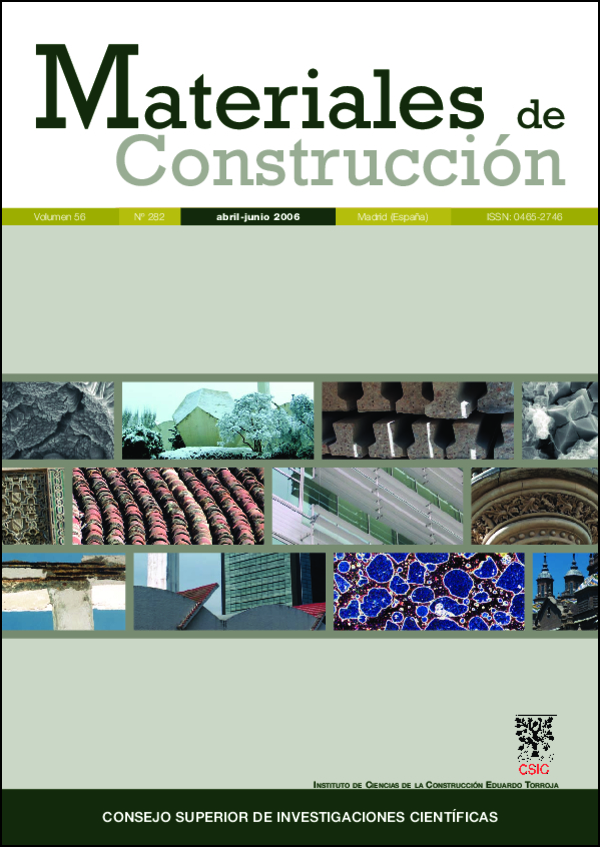Shear strength of match cast dry joints of precast concrete segmental bridges: proposal for Eurocode 2
DOI:
https://doi.org/10.3989/mc.2006.v56.i282.26Keywords:
segmental bridges, match cast joints, shearstrength, shear keys, high strength concreteAbstract
This paper discusses a study on the performance of concretesegmental bridges with shear keys, focusing on theshear behaviour of castellated dry joints under ultimatelimit state conditions. The widely varying formulationused to evaluate joint shear strength were compiled,along with the experimental results published in the literatureon the subject. The various approaches were evaluatedby comparing their predictions of ultimate jointstrength to published empirical findings. The formulagiving the best prediction was adapted to the safety factorprovisions set out in Eurocode 2.
Downloads
References
(1) Muller, J.: “Construction of the Long Key Bridge”, Journal of the Prestressed Concrete Institute, november-december (1980), pp. 97-111.
(2) Shafer, G.: “Bangkok Blockbuster”, Civil Engineering Magazine. ASCE, vol. 69, n. 1, january (1999), pp. 32-35.
(3) Ramirez, G., MacGregor, R., Kreger, M. E., Roberts-Wollmann, C., Breen, J.: “Shear Strength of Segmental Structures”, Proceedings of the Workshop AFPC External Prestressing in Structures. Saint-Remy-les-Chevreuse, june (1993), pp. 287-296.
(4) Buyukozturk, O., Backhoum, M. M., Beattie, S. M.: “Shear Behavior of Joints in Precast Concrete Segmental Bridges”, ASCE Journal of Structural Engineering, december (1990), pp. 3380-3401. doi:10.1061/(ASCE)0733-9445(1990)116:12(3380)
(5) Foure, B., Bouafia, Y., Soubret, R., Thomas, P.: “Shear Test on Keyed Joints between Precast Segments”, Proceedings of the Workshop AFPC External Prestressing in Structures, Saint-Remy-les-Chevreuse, june (1993), pp. 297-319.
(6) Aparicio, A. C., Ramos, G., Casas, J. R.: “Testing of externally prestressed concrete beams”, Engineering Structures, n. 24 (2001), pp. 73-84.
(7) Roberts, C. L.: “Measurement Based Revisions for Segmental Bridge Design and Construction Criteria”, PhD Dissertation, The University of Texas at Austin, december (1993).
(8) Bakhoum, M. M.: “Shear Behaviour and Design of Joints in Precast Concrete Segmental Bridges”, PhD Dissertation, Massachussetts Institute of Technology, 1991.
(9) Beattie, S. M.: “Behavioral Improvements in Segmental Concrete Bridge Joints through the Use of Steel Fibers”, MS Dissertation, Massachussetts Institute of Technology, 1989.
(10) Polo, T.: “Experimental Study on Shear Strength of Precast Concrete Segmental Bridges”, MSc Thesis, Universitat Politecnica de Catalunya, Barcelona, Espana, 2001 (in Spanish).
(11) Llopart, S.: “Experimental Study on Shear Strength of Dry Joints of SFRC Segmental Bridges”, MSc Thesis, Universitat Politecnica de Catalunya, Barcelona, Espana, 2001 (in Spanish).
(12) Koseki, K., Breen, J.: “Exploratory Study of Shear Strength of Joints for Precast Segmental Bridges”, Texas State Department of Highways and Public Transportation, september (1983).
(13) EC 2 1-5 UNE-ENV 1992-1-5: “General Guidelines for Unbonded or External Prestressed Structures”, AENOR, april (1996).
(14) AASHTO: “Guide Specifications for Design and Construction of Segmental Concrete Bridges”, Washington, 1998.
(15) ATEP: “Proyecto y construccion de puentes y estructuras con pretensado exterior”, Madrid, septiembre (1996).
(16) Turmo, J.: “Flexure and Shear Behaviour of Segmental Concrete Bridges with External Prestressing and Dry Joints” (in Spanish). ETSICCP de Barcelona. Dept. Ing. de la Construccion, julio (2003).
Downloads
Published
How to Cite
Issue
Section
License
Copyright (c) 2006 Consejo Superior de Investigaciones Científicas (CSIC)

This work is licensed under a Creative Commons Attribution 4.0 International License.
© CSIC. Manuscripts published in both the print and online versions of this journal are the property of the Consejo Superior de Investigaciones Científicas, and quoting this source is a requirement for any partial or full reproduction.
All contents of this electronic edition, except where otherwise noted, are distributed under a Creative Commons Attribution 4.0 International (CC BY 4.0) licence. You may read the basic information and the legal text of the licence. The indication of the CC BY 4.0 licence must be expressly stated in this way when necessary.
Self-archiving in repositories, personal webpages or similar, of any version other than the final version of the work produced by the publisher, is not allowed.
















